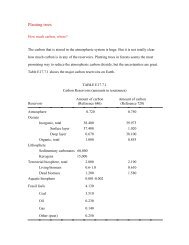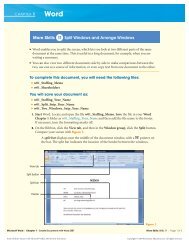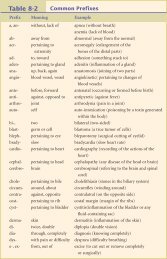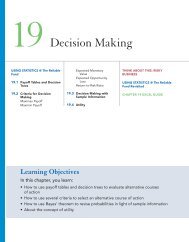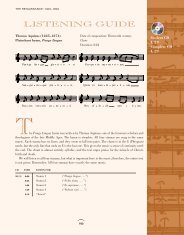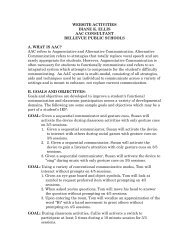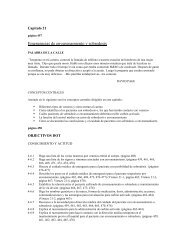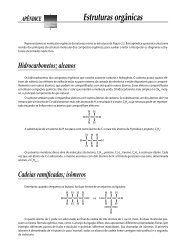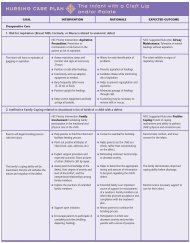chapter
chapter
chapter
You also want an ePaper? Increase the reach of your titles
YUMPU automatically turns print PDFs into web optimized ePapers that Google loves.
212 Unit Three Forces Within<br />
that part of California west of the fault zone, including<br />
the Baja Peninsula, will become an island off the West<br />
Coast of the United States and Canada. It could eventually<br />
reach Alaska. However, a more immediate concern<br />
is the earthquake activity triggered by movements<br />
along this fault system.<br />
?S TUDENTS SOMETIMES ASK...<br />
If the continents move,<br />
do other features like segments<br />
of the oceanic ridge also move?<br />
That’s a good observation, and yes, they do! It is interesting<br />
to note that very little is really fixed in place on Earth’s surface.<br />
When we talk about movement of features on Earth, we must<br />
consider the question, “Moving relative to what?” Certainly,<br />
the oceanic ridge does move relative to the continents (which<br />
sometimes causes segments of the oceanic ridges to be subducted<br />
beneath the continents). In addition, the oceanic ridge<br />
is moving relative to a fixed location outside Earth. This means<br />
that an observer orbiting above Earth would notice, after only<br />
a few million years, that all continental and seafloor features—<br />
as well as plate boundaries—are indeed moving. The exception<br />
to this are hot spots, which seem to be relatively<br />
stationary and can be used to determine the motions of other<br />
features.<br />
Testing the Plate Tectonics Model<br />
With the birth of the plate tectonics model, researchers<br />
from all of the Earth sciences began testing it. Some of<br />
the evidence supporting continental drift and seafloor<br />
spreading has already been presented. Some of the evidence<br />
that was instrumental in solidifying the support<br />
for this new concept follows. Note that some of the evidence<br />
was not new; rather, it was a new interpretation<br />
of old data that swayed the tide of opinion.<br />
Evidence: Paleomagnetism<br />
Probably the most persuasive evidence to the geologic<br />
community for the acceptance of the plate tectonics theory<br />
comes from the study of Earth’s magnetic field.<br />
Anyone who has used a compass to find direction<br />
knows that the magnetic field has a north pole and a<br />
south pole. These magnetic poles align closely, but not<br />
exactly, with the geographic poles. (The geographic<br />
poles are simply the top and bottom of the spinning<br />
sphere we live on, the points through which passes the<br />
imaginary axis of rotation.)<br />
In many respects the magnetic field is very much<br />
like that produced by a simple bar magnet. Invisible<br />
lines of force pass through Earth and extend from one<br />
pole to the other. A compass needle, itself a small magnet<br />
free to move about, becomes aligned with these lines<br />
of force and thus points toward the magnetic poles.<br />
The technique used to study ancient magnetic fields<br />
relies on the fact that certain rocks contain minerals that<br />
serve as fossil compasses. These iron-rich minerals, such<br />
as magnetite, are abundant in lava flows of basaltic composition.<br />
When heated above a certain temperature<br />
called the Curie point, these magnetic minerals lose their<br />
magnetism. However, when these iron-rich grains cool<br />
below their Curie point (about 580°C),<br />
they become<br />
magnetized in the direction parallel to the existing magnetic<br />
field. Once the minerals solidify, the magnetism<br />
they possess will remain frozen in this position. In this<br />
regard, they behave much like a compass needle inasmuch<br />
as they point toward the existing magnetic poles.<br />
Then, if the rock is moved or if the magnetic pole<br />
changes position, the rock magnetism will, in most instances,<br />
retain its original alignment. Rocks formed<br />
thousands of millions of years ago thus remember the<br />
location of the magnetic poles at the time of their formation<br />
and are said to possess fossil magnetism, or<br />
paleomagnetism.<br />
Polar Wandering. A study of lava flows conducted<br />
in Europe in the 1950s led to an amazing discovery.<br />
The magnetic alignment in the iron-rich minerals in<br />
lava flows of different ages was found to vary widely.<br />
A plot of the apparent positions of the magnetic north<br />
pole revealed that during the past 500 million years,<br />
the location of the pole had gradually wandered from<br />
a spot near Hawaii northward through eastern Siberia<br />
and finally to its present site (Figure 7.17A). This was<br />
clear evidence that either the magnetic poles had migrated<br />
through time, an idea known as polar wandering,<br />
or that the lava flows had moved—in other words,<br />
the continents had drifted.<br />
Although the magnetic poles are known to move,<br />
studies of the magnetic field indicated that the average<br />
positions of the magnetic poles correspond closely to<br />
the positions of the geographic poles. This is consistent<br />
with our knowledge of Earth’s magnetic field, which is<br />
generated in part by the rotation of Earth about its axis.<br />
If the geographic poles do not wander appreciably,<br />
which we believe is true, neither can the magnetic poles.<br />
Therefore, a more acceptable explanation for the apparent<br />
polar wandering is provided by the plate tectonics<br />
theory. If the magnetic poles remain stationary, their<br />
apparent movement was produced by the drifting of the<br />
continents.<br />
Further evidence for plate tectonics came a few<br />
years later when polar wandering curves were constructed<br />
for North America and Europe (Figure 7.17A).<br />
To nearly everyone’s surprise, the curves for North<br />
America and Europe had similar paths, except that they<br />
were separated by about 24 degrees of longitude. When<br />
these rocks solidified, could there have been two magnetic<br />
north poles that migrated parallel to each other?<br />
This is very unlikely. The differences in these migration<br />
paths, however, can be reconciled if the two presently




